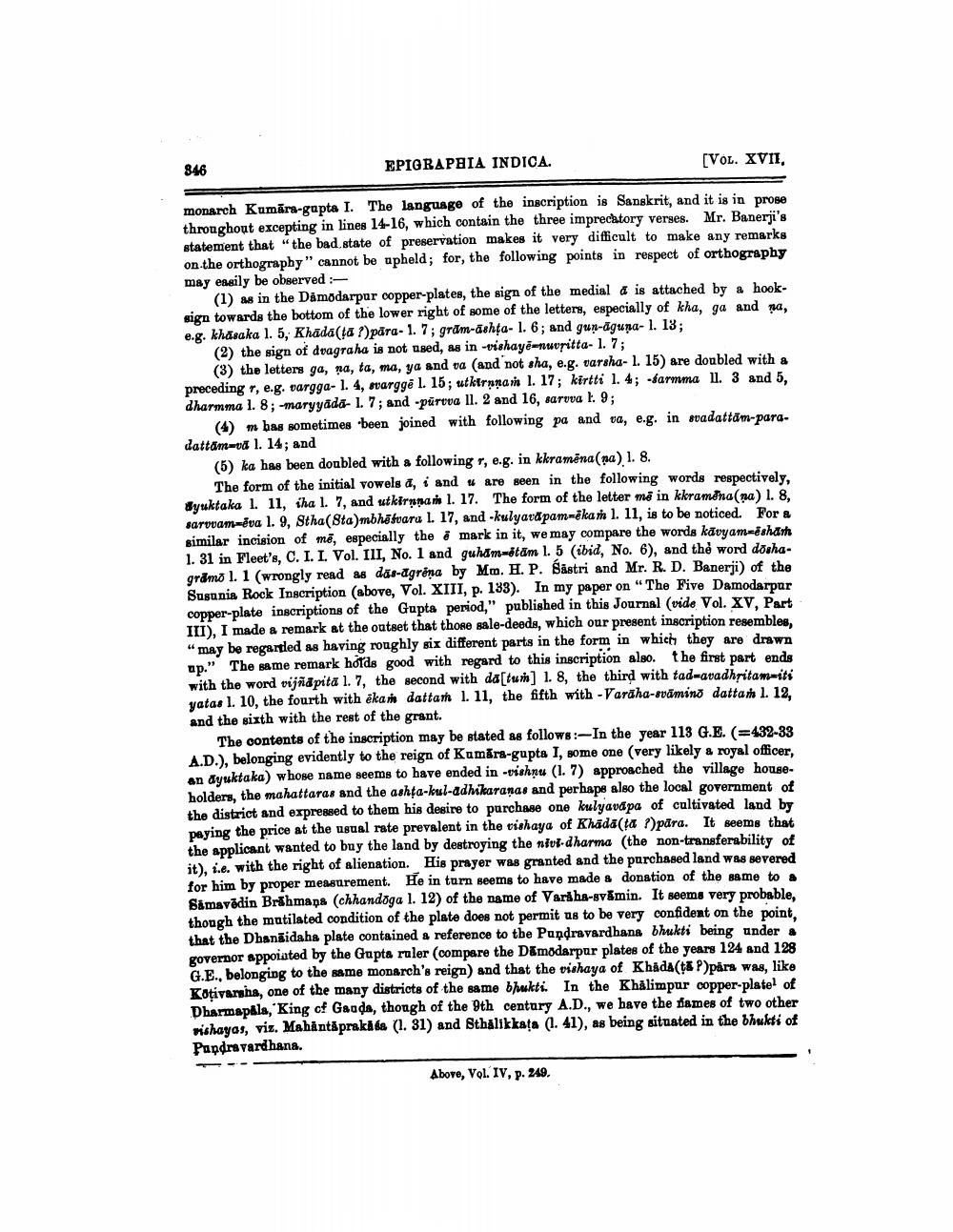________________
EPIGRAPHIA INDICA.
[VOL. XVII,
monarch Kumara-gupta I. The language of the inscription is Sanskrit, and it is in prose throughout excepting in lines 14-16, which contain the three imprecatory verses. Mr. Banerji's statement that "the bad state of preservation makes it very difficult to make any remarks on the orthography" cannot be upheld; for, the following points in respect of orthography may easily be observed:
(1) as in the Damodarpur copper-plates, the sign of the medial a is attached by a hooksign towards the bottom of the lower right of some of the letters, especially of kha, ga and na, e.g. khasaka l. 5, Khada (ta ?)para- 1. 7; gram-ashta- 1. 6; and gun-aguna- 1. 13;
(2) the sign of dvagraha is not used, as in -vishaye-nuvritta- 1. 7;
(3) the letters ga, na, ta, ma, ya and va (and not sha, e.g. varsha- 1. 15) are doubled with a preceding r, e.g. vargga- 1. 4, svargge 1. 15; utkirṇnam 1. 17; kirtti 1. 4; -sarmma 11. 3 and 5, dharmma 1. 8; -maryyada- 1. 7; and -pureva ll. 2 and 16, sarvva l. 9;
846
(4) m has sometimes been joined with following pa and va, e.g. in evadattām-paradattam-va 1. 14; and
(5) ka has been doubled with a following r, e.g. in kkramena (na) 1. 8.
The form of the initial vowels a, i and u are seen in the following words respectively, Byuktaka 1. 11, iha 1. 7, and utkirṛṇam 1. 17. The form of the letter me in kkramena(na) 1. 8, sarvvam-eva 1. 9, Stha (Sta)mbhetvara 1. 17, and -kulyavapam-ěkam 1. 11, is to be noticed. For a similar incision of me, especially the mark in it, we may compare the words kavyam-ëshām 1. 31 in Fleet's, C. I. I. Vol. III, No. 1 and guham-etām 1. 5 (ibid, No. 6), and the word doshagrämö 1. 1 (wrongly read as das-agrēna by Mm. H. P. Sastri and Mr. R. D. Banerji) of the Susunia Rock Inscription (above, Vol. XIII, p. 133). In my paper on "The Five Damodarpur copper-plate inscriptions of the Gupta period," published in this Journal (vide Vol. XV, Part III), I made a remark at the outset that those sale-deeds, which our present inscription resembles, "may be regarded as having roughly six different parts in the form in which they are drawn up." The same remark holds good with regard to this inscription also. the first part ends with the word vijnapita 1. 7, the second with da[tum] 1. 8, the third with tad-avadhritam-iti yatas 1. 10, the fourth with ekam dattam 1. 11, the fifth with -Varaha-svamino dattam 1. 12, and the sixth with the rest of the grant.
The contents of the inscription may be stated as follows:-In the year 113 G.E. (=432-33 A.D.), belonging evidently to the reign of Kumara-gupta I, some one (very likely a royal officer, an ayuktaka) whose name seems to have ended in -vishnu (1. 7) approached the village householders, the mahattaras and the ashța-kul-adhikaranas and perhaps also the local government of the district and expressed to them his desire to purchase one kulyavapa of cultivated land by paying the price at the usual rate prevalent in the vishaya of Khada (ta ?)pära. It seems that the applicant wanted to buy the land by destroying the nivi-dharma (the non-transferability of it), i.e. with the right of alienation. His prayer was granted and the purchased land was severed for him by proper measurement. He in turn seems to have made a donation of the same to a Samavedin Brahmana (chhandōga 1. 12) of the name of Varaha-svamin. It seems very probable, though the mutilated condition of the plate does not permit us to be very confident on the point, that the Dhanaidaha plate contained a reference to the Pundravardhana bhukti being under a governor appointed by the Gupta ruler (compare the Damodarpur plates of the years 124 and 128 G.E., belonging to the same monarch's reign) and that the vishaya of Khada(tä?)pära was, like Kotivarsha, one of the many districts of the same bhakti. In the Khalimpur copper-plate1 of Dharmapala, King of Gauda, though of the 9th century A.D., we have the names of two other vishayas, viz. Mahäntäprakasa (1. 31) and Sthalikkața (1. 41), as being situated in the bhukti of Pandravardhana.
Above, Vol. IV, p. 249.




